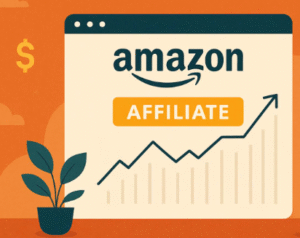
In the previous article, we explored an overview of Amazon Affiliate Marketing and the process of registering for an Amazon Associates account. Once you have an account, the next critical step that determines your success is selecting a high-potential niche and building a robust blog platform.
A well-chosen niche not only helps you reach the right audience but also optimizes your marketing efforts. Meanwhile, a professional website serves as the “home” for creating high-quality content and attracting traffic. Let’s dive into each step in detail.
I. Choosing a High-Potential Niche and Suitable Products
Selecting the right niche is the first and most crucial step in building a successful affiliate blog. A suitable niche allows you to target the right audience, focus your resources, and enhance marketing efficiency.
1. Criteria for Choosing a Niche
To select an ideal niche, consider the following factors:
- Passion and Knowledge: Choose a field you’re passionate about or have in-depth knowledge of. When you truly understand your niche, you can create detailed, trustworthy content and provide better product evaluations than your audience, establishing yourself as an expert in their eyes.
- Market Demand: Ensure the niche has sufficient user demand to generate potential revenue. A niche that’s too narrow or lacks demand will struggle to produce sustainable income.
- Competition Level: Opt for a niche with high demand but moderate competition to make ranking and selling products easier. Avoid overly competitive niches or products with no real demand, as these can waste time and effort.
- Available Products on Amazon: Confirm that Amazon offers a sufficient and diverse range of products related to your chosen niche for promotion.
The ideal niche is the intersection of passion, market demand, and profit potential. Choosing a niche solely based on profit potential without passion or knowledge makes it hard to stay motivated, produce high-quality content, or become a trusted expert. Conversely, passion without market demand won’t generate income. Balancing these three factors is essential for building a sustainable and successful affiliate blog.
2. Selecting Products Within the Niche
After identifying your niche, choosing specific products to promote is equally important:
- Best Sellers: Prioritize products listed in Amazon’s Best Seller category. These products have proven sales and positive reviews, indicating clear market demand.
- Mid-Range Value: Select products with moderate price points. These are often easier for buyers to decide on compared to very high-priced items.
- Commission Rates: Research the commission rates Amazon offers for each product category to ensure profit potential. Amazon’s commission rates range from 1% to 20%, depending on the category. Below is a reference table for commission rates of popular categories:
| Product Category | Fixed Commission Rate |
|---|---|
| Amazon Games | 20.00% |
| Luxury Beauty, Luxury Stores Beauty, Amazon Explore | 10.00% |
| Amazon Haul | 7.00% |
| Digital Music, Physical Music, Handmade, Digital Videos | 5.00% |
| Physical Books, Kitchen, Automotive | 4.50% |
| Amazon Fire Tablet Devices, Kindle Devices, Amazon Fashion Private Label, Luxury Stores Fashion, Apparel, Echo Devices, Ring Devices, Watches, Jewelry, Luggage, Shoes, Handbags & Accessories | 4.00% |
| Toys, Furniture, Home, Home Improvement, Lawn & Garden, Pets Products, Headphones, Beauty, Musical Instruments, Business & Industrial Supplies, Outdoors, Tools, Sports, Baby Products, Amazon Coins | 3.00% |
| PC, PC Components, DVD & Blu-Ray | 2.50% |
| Televisions, Digital Video Games | 2.00% |
| Amazon Fresh, Physical Video Games & Consoles, Grocery, Health & Personal Care | 1.00% |
| Gift Cards, Wireless Service Plans, Alcoholic Beverages, Digital Kindle Products (subscription), Vehicles, Pet Prescription Medications, Food (restaurant), Amazon Appstore, Prime Now, Amazon Pay Places | 0.00% |
| All Other Categories | 4.00% |
Export to Sheets
- Research Tools: Use product research and market data analysis tools like Synccentric and Ecomspy for deeper insights into competitors and product potential.
II. Building a Robust Affiliate Marketing Blog Platform
A website or blog is the cornerstone of effective affiliate marketing. Amazon requires Publishers to own a website or blog to join the Associates Program.
1. Choosing a Website Platform
Selecting the right website platform is a critical decision that impacts scalability and optimization:
- Free Website/Blog Platforms (WordPress.com, Blogger, Wix, Weebly): These are good options for beginners due to low (often free) costs and ease of use, requiring minimal coding skills. However, they have significant drawbacks, such as limited customization, unprofessional domain names (e.g., yourname.wordpress.com), and lack of full ownership over your site.
- Paid Website/Blog Platforms (WordPress.org with separate hosting): For a professional, scalable, and sustainable website, this is the recommended choice. With this option, you purchase a custom domain, use hosting services, and have full control over customization and functionality.
Investing in a professional platform is an investment in a long-term digital asset. While free platforms may seem appealing due to zero upfront costs, their limitations in customization, unprofessional domains, and lack of control hinder SEO optimization, scalability, and brand-building in the long run. Conversely, a paid platform like self-hosted WordPress offers flexibility and full control, turning your blog into a true digital asset.
2. Basic Steps to Set Up a Paid WordPress Website/Blog
To set up a professional WordPress website/blog, follow these steps:
- Purchase a Domain Name: Choose a short, memorable domain name relevant to your niche (e.g., techreview.com). The domain is your website’s unique internet address.
- Purchase and Set Up Hosting: Select a reputable hosting provider to store your website’s data and files, ensuring 24/7 online availability.
- Install WordPress: Most hosting providers offer one-click WordPress installation tools. WordPress is a popular and powerful content management system (CMS) for building affiliate blogs.
- Design the Interface (Theme): Choose a WordPress theme suited to your niche and blog goals. Themes like Flatsome are popular for e-commerce or affiliate sites due to their flexibility and customization options.
- Install Essential Plugins: Install key plugins like Yoast SEO (for SEO optimization), caching plugins (to improve page load speed), and affiliate-specific plugins like WooZone (to import Amazon products and manage affiliate links efficiently).
III. Conclusion
Choosing the right niche and building a professional blog platform are two strategic steps that lay a solid foundation for success in Amazon Affiliate Marketing. A thoroughly researched niche helps you focus your resources, while a well-set-up website becomes a powerful tool for implementing content and SEO strategies.
In the next article, we’ll explore Effective Content & SEO Strategies for Affiliate Blogs, where you’ll learn how to conduct in-depth keyword research, create engaging content types, and optimize on-page SEO to propel your blog to the top of search results.



